
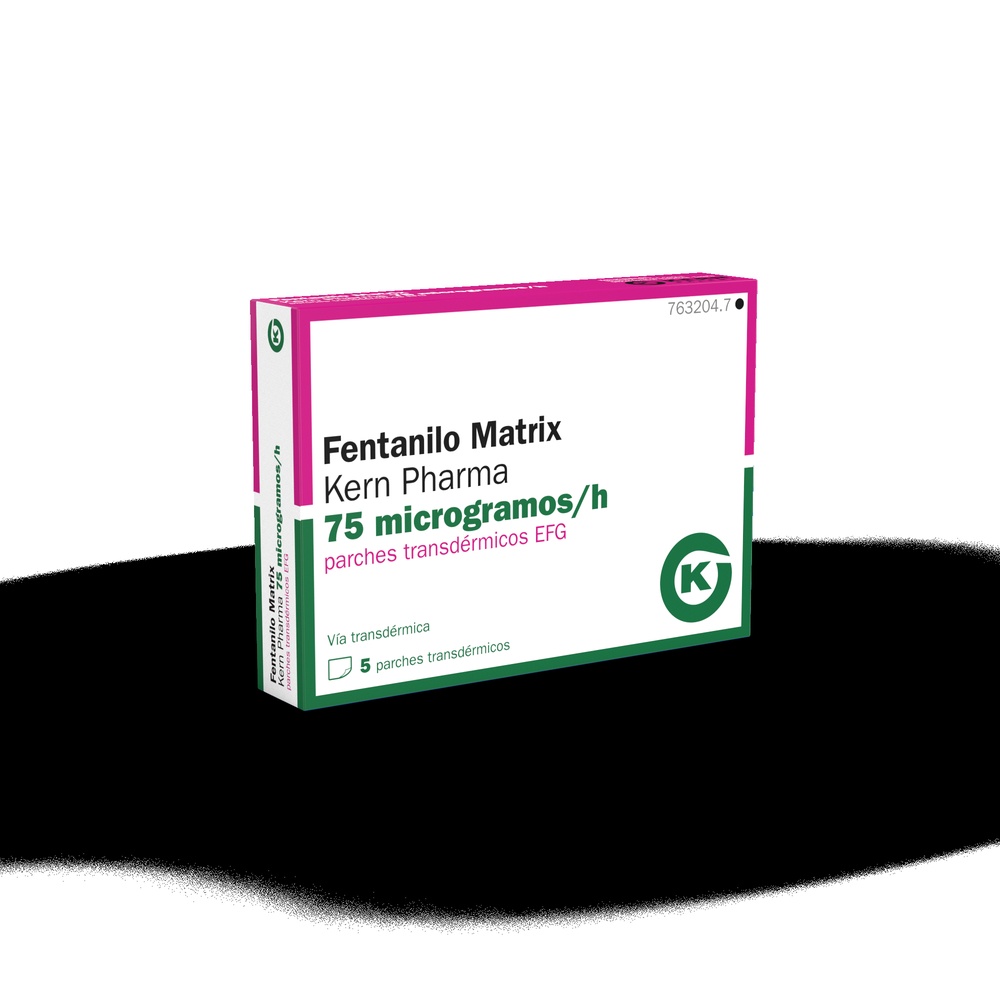
FENTANIL MATRIX VIATRIS 75 mcg/H TRANSDERMAL PATCHES

Ask a doctor about a prescription for FENTANIL MATRIX VIATRIS 75 mcg/H TRANSDERMAL PATCHES

How to use FENTANIL MATRIX VIATRIS 75 mcg/H TRANSDERMAL PATCHES
Introduction
Package Leaflet: Information for the Patient
Fentanilo Matrix Viatris 75 micrograms/hour transdermal patches EFG
Read all of this leaflet carefully before you start using this medicine because it contains important information for you.
- Keep this leaflet, you may need to read it again.
- If you have any further questions, ask your doctor, pharmacist, or nurse.
- This medicine has been prescribed for you only. Do not pass it on to others. It may harm them, even if their symptoms are the same as yours.
- If you get any side effects, talk to your doctor, pharmacist, or nurse. This includes any possible side effects not listed in this leaflet. See section 4.
Contents of the pack
- What is Fentanilo Matrix Viatris and what is it used for
- What you need to know before you use Fentanilo Matrix Viatris
- How to use Fentanilo Matrix Viatris
- Possible side effects
- Storing Fentanilo Matrix Viatris
- Contents of the pack and further information
1. What is Fentanilo Matrix Viatris and what is it used for
The name of your medicine is Fentanilo Matrix Viatris.
The patches help to relieve very strong and long-lasting pain.
- In adults who need continuous treatment for pain.
- In children over 2 years who are already using opioid medicines and who need continuous treatment for pain.
Fentanilo Matrix Viatris contains a medicine called fentanyl. It belongs to a group of strong painkillers called opioids.
2. What you need to know before you use Fentanilo Matrix Viatris
Do not use Fentanilo Matrix Viatris if:
- You are allergic to fentanyl or any of the other ingredients of this medicine (listed in section 6).
- You have pain that lasts only for a short period, such as sudden pain or pain after an operation.
- You have breathing difficulties, with slow or shallow breathing.
Do not use this medicine if you or your child have any of the above conditions. If in doubt, consult your doctor or pharmacist before using Fentanilo Matrix Viatris.
Warnings and precautions
- Fentanilo Matrix Viatris can have potentially life-threatening side effects in people who do not regularly use prescribed opioid medicines.
- Fentanilo Matrix Viatris is a potentially life-threatening medicine for children, even if the patches have already been used. Note that an adhesive patch (used or unused) can be tempting for a child, and if it is stuck to a child's skin or put in their mouth, it can be fatal.
- Keep this medicine in a safe and secure place, where others cannot access it, for more information see section 5.
Applying the patch to another person
The patch should only be used on the skin of the person it has been prescribed for. There have been reports of patches accidentally sticking to a family member if there is physical contact or if the same bed is shared with the person wearing the patch. A patch that accidentally sticks to another person (especially a child) can cause the medicine to pass through the skin of the other person and cause serious side effects, such as breathing difficulties, with slow or shallow breathing, which can be fatal. If the patch sticks to another person's skin, remove it immediately and seek medical attention.
Be careful with Fentanilo Matrix Viatris
Consult your doctor or pharmacist before using this medicine if any of the following apply to you; your doctor may need to monitor you more closely if:
- You have ever had problems with your lungs or breathing.
- You have ever had problems with your heart, liver, kidneys, or low blood pressure.
- You have ever had a brain tumor.
- You have ever had persistent headaches or head injuries.
- You are elderly, you may be more sensitive to the effects of this medicine.
- You have a condition called "myasthenia gravis", where the muscles weaken and get tired easily.
If any of the above apply to you (or if you are not sure), consult your doctor or pharmacist before using fentanyl.
While using the patch, tell your doctor if you have breathing problems while sleeping.Opioids like fentanyl can cause sleep-related breathing disorders such as sleep apnea (breathing pauses while sleeping) and sleep-related hypoxemia (low oxygen level in the blood). Talk to your doctor if you, your partner, or caregiver notice any of the following symptoms:
- breathing pauses while sleeping
- waking up at night due to lack of air
- difficulty staying asleep
- excessive sleepiness during the day.
Your doctor may decide to change the dose.
While using the patch, tell your doctor if you notice a change in the pain you feel.If you:
- feel that the patch no longer relieves the pain
- experience an increase in pain
- notice a change in the way you feel the pain (for example, you feel pain in another part of your body)
- feel pain when there is contact with your body that should not cause pain.
Do not change the dose on your own. Your doctor may decide to change the dose or change the treatment.
Side effects and Fentanilo Matrix Viatris
- Fentanyl may make you unusually drowsy and may cause you to breathe more slowly or shallowly. In rare cases, these breathing problems can be life-threatening, especially in people who have not previously used strong opioid painkillers (such as Fentanilo Matrix Viatris) or morphine. If you, your partner, or caregiver notice that the person wearing the patch is unusually drowsy, with slow or shallow breathing:
- Remove the patch.
- Call a doctor or go to the nearest hospital immediately.
- Keep the person moving and talking as much as possible.
- If you have a fever while using fentanyl, tell your doctor: this can increase the amount of medicine that passes through the skin.
- Fentanyl can cause constipation, consult your doctor or pharmacist for advice on how to avoid or relieve constipation.
See section 4 for a complete list of possible side effects.
Long-term use and tolerance
This medicine contains fentanyl, an opioid. Repeated use of opioid painkillers can make the medicine less effective (the body gets used to it, which is known as pharmacological tolerance). You may also become more sensitive to pain when using fentanyl. This is known as hyperalgesia. Increasing the dose of the patches may continue to reduce the pain for a while, but it can also be harmful. If you notice that the medicine is becoming less effective, consult your doctor. Your doctor will decide whether it is better to increase the dose or gradually reduce the use of fentanyl.
Dependence and addiction
This medicine contains fentanyl, which is an opioid. It can cause dependence and/or addiction. |
Repeated use of fentanyl can also lead to dependence, abuse, and addiction, which can result in a potentially life-threatening overdose. The risk of these side effects may be greater with a higher dose and longer use. Dependence or addiction can cause a feeling of lack of control over the amount of medicine you need to use or how often you need to use it. You may feel the need to continue using the medicine even if it no longer relieves the pain.
The risk of dependence or addiction varies from person to person. The risk of becoming dependent on or addicted to fentanyl may be greater if:
- You or any member of your family have abused alcohol or have been dependent on it, or have abused prescription medicines or illegal drugs ("addiction").
- You smoke.
- You have ever had problems with your mood (depression, anxiety, or personality disorder) or have been treated by a psychiatrist for other mental illnesses.
If you notice any of the following symptoms while using fentanyl, it could be a sign of dependence or addiction.
- You need to use the medicine for longer than prescribed by your doctor.
- You need to use a higher dose than recommended.
- You are using the medicine for reasons other than those prescribed, for example, "to calm down" or "to help you sleep".
- You have made repeated unsuccessful attempts to stop using the medicine or control its use.
- You feel unwell when you stop using the medicine, and you feel better once you start taking it again ("withdrawal symptoms").
If you notice any of these signs, consult your doctor to determine the best treatment for you, when it is appropriate to stop the medicine, and how to do it safely.
If you are using the patch, do not expose it to direct heat sources, such as electric blankets, hot water bottles, heated beds, or heat lamps. Do not sunbathe or take long hot baths. Do not go to saunas, hot tubs, or steam rooms. If you do, you may increase the amount of medicine you receive from the patch.
Other medicines and Fentanilo Matrix Viatris
Tell your doctor or pharmacist if you are using, have recently used, or might use any other medicines. This includes medicines you buy without a prescription or herbal remedies. If you buy medicines at the pharmacy, you must also tell the pharmacist that you are using fentanyl.
Your doctor will know which medicines you can safely take with fentanyl. You may need to be monitored closely if you are taking or stop taking some of the types of medicines listed below, as this may affect the strength of fentanyl you need.
In particular, tell your doctor or pharmacist if you are taking:
- Other pain medicines, such as other strong opioid painkillers (e.g., buprenorphine, nalbuphine, or pentazocine) and some painkillers for nerve pain (gabapentin and pregabalin).
- Medicines to help you sleep (such as temazepam, zaleplon, or zolpidem).
- Medicines to help you calm down (tranquilizers, such as alprazolam, clonazepam, diazepam, hydroxyzine, or lorazepam) and medicines for mental health conditions (antipsychotics, such as aripiprazole, haloperidol, olanzapine, risperidone, or phenothiazines).
- Medicines to relax your muscles (such as cyclobenzaprine or diazepam).
- Some medicines used to treat depression called SSRIs or SNRIs (such as citalopram, duloxetine, escitalopram, fluoxetine, fluvoxamine, paroxetine, sertraline, or venlafaxine). See below for more information.
- Some medicines used to treat depression or Parkinson's disease called MAOIs (such as isocarboxazid, phenelzine, selegiline, or tranylcypromine). You must not take fentanyl in the 14 days after stopping these medicines: see below for more information.
- Some antihistamines, especially those that make you drowsy (such as chlorpheniramine, clemastine, cyproheptadine, diphenhydramine, or hydroxyzine).
- Some antibiotics used to treat infections (such as erythromycin or clarithromycin).
- Medicines used to treat fungal infections (such as itraconazole, ketoconazole, fluconazole, or voriconazole).
- Medicines used to treat HIV infection (such as ritonavir).
- Medicines used to treat irregular heartbeats (such as amiodarone, diltiazem, or verapamil).
- Medicines used to treat tuberculosis (such as rifampicin).
- Some medicines used to treat epilepsy (such as carbamazepine, phenobarbital, or phenytoin).
- Some medicines used to treat nausea or vomiting (such as phenothiazines).
- Some medicines used to treat sunburn or ulcers (such as cimetidine).
- Some medicines used to treat angina (chest pain) or high blood pressure (such as nicardipine).
- Some medicines used to treat blood cancer (such as idelalisib).
Fentanilo Matrix Viatris with antidepressants
The risk of side effects increases if you are taking medicines such as certain antidepressants. Fentanyl can interact with these medicines and you may experience changes in your mental state, such as excitement, seeing, feeling, hearing, or smelling things that are not there (hallucinations), and other effects such as changes in blood pressure, rapid heartbeat, high body temperature, overactive reflexes, lack of coordination, muscle stiffness, nausea, vomiting, and diarrhea.
Use with central nervous system depressants, including alcohol and certain narcotics
Tell your doctor if you are taking any other medicine that slows down your central nervous system (CNS depressant). For example, CNS depressants are medicines that make you drowsy, reduce anxiety, or reduce consciousness (see also "Other medicines and Fentanilo Matrix Viatris"); alcohol and certain narcotics are also CNS depressants. Taking this type of medicine with Fentanilo Matrix Viatris can cause severe drowsiness, reduced consciousness, breathing difficulties with slow or shallow breathing, coma, or death.
Do not drink alcohol while using Fentanilo Matrix Viatris, unless you have talked to your doctor first.
Surgery
If you think you are going to have an anesthetic, tell your doctor or dentist that you are using fentanyl.
Pregnancy and breastfeeding
If you are pregnant or breastfeeding, think you may be pregnant, or plan to become pregnant, consult your doctor or pharmacist before using this medicine.
Fentanyl should not be used during pregnancy, unless you have talked to your doctor.
Fentanyl should not be used during labor, as the medicine can affect the breathing of the newborn.
Do not use fentanyl if you are breastfeeding. You should not breastfeed for 3 days after removing the fentanyl patch. This is because the medicine can pass into breast milk.
Driving and using machines
Fentanyl can affect your ability to drive and use machines or tools, as it can cause drowsiness or dizziness. If this happens, do not drive or use tools or machines. Do not drive while using this medicine until you know how it affects you.
Talk to your doctor or pharmacist if you are not sure if it is safe to drive while taking this medicine.
3. How to use Fentanilo Matrix Viatris
Follow the administration instructions for this medication exactly as indicated by your doctor. In case of doubt, consult your doctor or pharmacist again.
The doctor will decide which dose of Fentanilo Matrix Viatris is most suitable, taking into account the severity of the pain, your general condition, and the type of pain treatment you have received so far.
Before starting treatment and regularly during treatment, your doctor will also explain what you can expect from using fentanyl, when and for how long you should use it, when you should contact your doctor, and when you should stop using it (see also section 2, "Withdrawal syndrome when stopping fentanyl treatment").
Using and changing patches
- There is enough medication in each patch to last 3 days (72 hours).
- You should change the patch every three days, unless your doctor has told you otherwise.
- Always remove the old patch beforeapplying a new one.
- Always change the patch at the same timeof day every 3 days (72 hours).
- If you use more than one patch, change them all at the same time.
- Make a note of the day, date, and time you apply the patch, so you remember when to change it.
- The following table shows when to change the patch:
Apply the patch on | Change the patch on | |
Monday | Thursday | |
Tuesday | Friday | |
Wednesday | Saturday | |
Thursday | Sunday | |
Friday | Monday | |
Saturday | Tuesday | |
Sunday | Wednesday |
Where to apply the patch
Adults
- Place the patch on a smooth surface on the upper part of the body or the arm (not over a joint).
Use in children
- Always apply the patch to the upper back, so the child cannot reach it and remove it.
- Check frequently that the patch is still stuck to the skin.
- It is essential that the child does not remove the patch and put it in their mouth, as this could pose a life-threatening risk.
- Monitor your child very closely for 48 hours after:
- Applying the first patch.
- Applying a patch with a higher dose.
- It may take some time for the patch to have its maximum effect. Therefore, your child may need additional pain relievers until the patches are fully effective. Your doctor will advise you if necessary.
Adultsand children:
Do not apply the patch to
- The same place twice in a row.
- Areas that move a lot (joints), irritated skin, or skin with cuts.
- Skin with a lot of hair. If there is hair, do not shave it (shaving irritates the skin). Instead, cut the hair with scissors as close to the skin as possible.
Applying a patch
Step 1: Preparing the skin
- Make sure the skin is completely dry, clean, and fresh before applying the patch.
- If you need to wash the skin, wash it with water.
- Do not use soap, oil, lotions, alcohol, or other cleansers that may irritate the skin.
- Do not apply the patch immediately after a hot bath or shower.
Step 2: Open the pouch
- Each patch is stored in a sealed bag.
- To open the pouch, make a small cut near the sealed edge of the pouch with the tip of scissors (figure 1).
Figure 1:
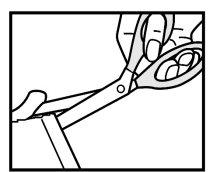
- Gently break the bag and open it with your hand completely (figure 2).
Figure 2:
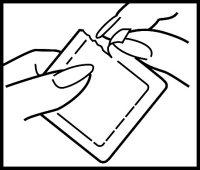
- Hold the two sides of the open pouch, pull them apart so that the pouch is open on three sides, and remove the patch (figure 3).
Figure 3:
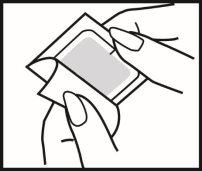
- Remove the patch and use it immediately (figure 4).
Figure 4:
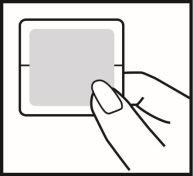
- Keep the empty pouch to dispose of the used patch later.
- Use each patch only once.
- Do not remove the patch from its pouch until you are ready to use it.
- Check the patch for damage.
- Do not use the patch if it is divided, cut, or appears to be damaged.
- Never divide or cut the patch.
Step 3: Peel and press
- Make sure the patch is covered by loose clothing and not trapped under a strap or elastic band.
- The patch should be applied immediately after opening the package. Once the protective film is removed, carefully peel off one half of the transparent protective layer away from the center of the patch. Try not to touch the adhesive side of the patch (figure 5).
Figure 5:
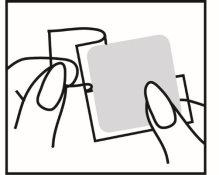
- Press this adhesive part of the patch onto the skin (figure 6).
Figure 6:
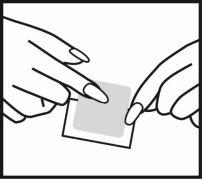
- Remove the other part of the transparent protective layer (figure 7).
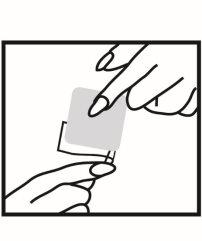 Figure 7:
Figure 7:
- Press the entire patch onto the skin with the palm of your hand.
- Maintain pressure for at least 30 seconds. Make sure the patch adheres well to the skin, especially at the edges (figure 8).
Figure 8:
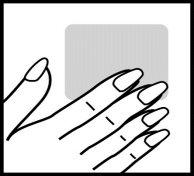
Step 4: How to dispose of the patch
- As soon as you remove the patch, fold it firmly in half so that it sticks together on the adhesive side.
- Return it to its original bag and dispose of the bag according to the instructions given by the pharmacist.
- Keep used patches out of sight and reach of children; although they are used, the patches contain medication that can harm children and can be life-threatening.
Step 5: Washing
- Always wash your hands after handling the patch, with clear water only.
More information about using Fentanilo Matrix Viatris
Day-to-day activities while using the patches
- The patches are waterproof.
- You can shower or bathe with the patch on, but do not rub it.
- If your doctor agrees, you can exercise or play sports with the patch on.
- You can also swim with the patch, but:
- Do not use it in saunas or hot tubs.
- Do not place a strap or elastic band over the patch.
- If you wear the patch, do not expose it to direct heat sources, such as electric pads, electric blankets, hot water bottles, waterbeds, or heat or tanning lamps. Do not sunbathe, take long hot baths, or go to saunas. If you do, you may increase the amount of medication you receive from the patch.
When will the patches start working?
- It may take some time for the first patch to have its maximum effect.
- Your doctor may provide you with other pain relievers, also for the first day.
- After that, the patch should help you relieve pain continuously, so you can stop taking other pain relievers. However, your doctor may prescribe additional pain relievers from time to time.
How long will you use the patches?
- Fentanyl patches are for long-term pain. Your doctor will indicate how long you can use the patches.
If the pain worsens
- If your pain worsens suddenly after applying the last patch, check the patch. If it is no longer sticking well or has come off, replace the patch (see also the section If the patch comes off).
- If your pain worsens over time while using the patches, your doctor may try a patch with a higher dose or give you an additional pain reliever (or both).
- If increasing the patch dose does not help, your doctor may decide to stop using the patches.
If you use too many patches or if you wear a patch with the wrong dose
If you have applied too many patches or the patch has an incorrect dose, remove them and contact your doctor or pharmacist immediately, call the Toxicology Information Service, phone 91 562 04 20 (indicating the medication and the amount applied), or go to the nearest hospital. Bring the packaging and remaining patches with you.
The signs of overdose include difficulty breathing or weak breathing, tiredness, extreme drowsiness, inability to think clearly, walk or talk normally, as well as fainting, dizziness, or confusion. An overdose can also cause a brain disorder known as toxic leukoencephalopathy.
If you forget to change the patch
- If you forget, change the patch as soon as you remember and make a note of the day and time. Change the patch again after 3 days (72 hours), as usual.
- If you delay changing the patch, you should talk to your doctor because you may need additional pain relievers, but do not apply another patch.
If a patch comes off
- If a patch comes off before it is due to be changed, apply a new one immediately and make a note of the day and time. Use a new area of skin on:
- The upper part of the body or the arm.
- Your child's shoulder.
- Tell your doctor what happened and leave the patch on for another 3 days (72 hours) or as indicated by your doctor, before changing the patch in the usual way.
- If the patches continue to fall off, talk to your doctor, pharmacist, or nurse.
If you want to stop using the patches
- Talk to your doctor if you want to stop using these patches.
- If you have been using them for a while, your body may have gotten used to them. If you stop using them suddenly, you may not feel well.
- If you stop using patches, do not start using them again without asking your doctor first. You may need a patch with a different dose when you start again.
If you have any other questions about using this medication, ask your doctor or pharmacist.
4. Possible side effects
Like all medications, this medication can cause side effects, although not everyone will experience them.
If you, your partner, or the caregiver notice any of the following in the person wearing the patch, remove it and call a doctor or go immediately to the nearest hospital. You may need urgent medical treatment.
- If you feel unusually drowsy, if you breathe more slowly or weakly than usual. Follow the advice indicated above and keep the person who was wearing the patch moving and talking as much as possible. In very rare cases, these breathing difficulties can be life-threatening, especially in people who have not previously used strong opioid pain relievers (such as fentanyl or morphine). (Uncommon, may affect up to 1 in 100 people).
- Sudden swelling of the face or throat, severe irritation, redness, or blisters on the skin. These can be signs of a severe allergic reaction (frequency cannot be estimated from the available data).
- Seizures (convulsions). (Uncommon, may affect up to 1 in 100 people).
- Loss of consciousness or decreased level of consciousness. (Uncommon, may affect up to 1 in 100 people).
The following side effects have also been reported
Very common (may affect more than 1 in 10 people)
- Nausea, vomiting, constipation.
- Drowsiness.
- Dizziness.
- Headache.
Common (may affect up to 1 in 10 people)
- Allergic reaction.
- Loss of appetite.
- Difficulty sleeping.
- Depression.
- Anxiety or confusion.
- Seeing, feeling, hearing, or smelling things that do not exist (hallucinations).
- Muscle tremors or spasms.
- Abnormal sensation in the skin, such as tingling or prickling (paresthesia).
- Feeling of movement (vertigo).
- Fast or irregular heartbeat (palpitations or tachycardia).
- High blood pressure.
- Shortness of breath (dyspnea).
- Diarrhea.
- Dry mouth.
- Stomach pain or indigestion.
- Excessive sweating.
- Itching, rash, or redness of the skin.
- Inability to urinate or empty the bladder completely.
- Feeling of fatigue, weakness, or general malaise.
- Feeling of cold.
- Swollen hands, feet, or ankles (peripheral edema).
Uncommon (may affect up to 1 in 100 people)
- Disorientation or excitement.
- Feeling of extreme happiness (euphoria).
- Decreased sensitivity, especially in the skin (hypoesthesia).
- Memory loss.
- Blurred vision.
- Slow heartbeat (bradycardia) or low blood pressure.
- Purple spots on the skin caused by low oxygen levels in the blood (cyanosis).
- Lack of bowel contractions (ileus).
- Itchy skin rashes (eczema), allergic reaction, or other skin disorders where the patch has been applied.
- Flu-like illness.
- Feeling of changed body temperature.
- Fever.
- Muscle spasms.
- Difficulty getting or maintaining an erection (impotence) or problems having sex.
- Difficulty swallowing.
Rare (may affect up to 1 in 1,000 people)
- Contraction of the pupils (miosis).
- Stopping breathing from time to time (apnea).
Not known (frequency cannot be estimated from the available data)
- Lack of male sex hormones (androgen deficiency).
- Delirium (symptoms may include a combination of agitation, restlessness, disorientation, confusion, fear, seeing or hearing things that do not really exist, sleep disturbances, nightmares).
- You may become dependent on fentanyl (see section 2).
You may notice rashes, redness, or mild itching of the skin in the patch area. This is usually mild and goes away after you remove the patch. If it does not, or if the patch irritates your skin a lot, tell your doctor.
Continuous use of the patches can make the medication become less effective (you become "tolerant" to it) or you may become dependent on it.
If you switch from another pain reliever to fentanyl or if you suddenly stop using fentanyl, you may notice a certain withdrawal syndrome such as discomfort, dizziness, nausea, diarrhea, anxiety, or tremors. Inform your doctor if you notice any of these effects.
There have also been reports of newborns suffering from withdrawal effects after their mothers used fentanyl for a long time during pregnancy.
Reporting side effects:
If you experience any side effects, consult your doctor, pharmacist, or nurse, even if they are possible side effects not listed in this leaflet. You can also report them directly through the Spanish Medicines Monitoring System for Human Use: https://www.notificaram.es. By reporting side effects, you can help provide more information on the safety of this medication.
5. Storing Fentanilo Matrix Viatris
Where should you keep the patches
Keep all patches (used and unused) out of sight and reach of children.
Store this medication in a safe and protected place, where others cannot access it. This medication can cause serious harm and even be life-threatening if used accidentally or intentionally by someone who has not been prescribed it.
How long can Fentanilo Matrix Viatris be stored
Do not use Fentanilo Matrix Viatris after the expiration date indicated on the box and the sealed bag. The expiration date is the last day of the month indicated. If the patches have expired, take them to the pharmacy.
This medication does not require special storage conditions.
How to dispose of used or unused patches
A used or unused patch that accidentally sticks to another person, especially a child, can be life-threatening.
Used patches must be folded firmly in half so that they stick together on the adhesive side. They should be disposed of safely; put them back in the original sealed bag and keep them out of sight and reach of others, especially children, until they are eliminated safely. Ask your pharmacist how to dispose of the packaging and medications you no longer need.
Medications should not be thrown down the drain or into the trash. Deposit the packaging and medications you no longer need in the SIGRE collection point at the pharmacy. If in doubt, ask your pharmacist how to dispose of the packaging and medications you no longer need. This way, you will help protect the environment.
6. Container Contents and Additional Information
Composition of Fentanilo Matrix Viatris
The active ingredient is fentanyl. Each transdermal patch contains 12.6 mg of fentanyl in a 31.5 cm2 surface area, releasing 75 micrograms of fentanyl per hour.
The other components are:
Acrylic adhesive, siliconized polyester film (protective film), polyethylene terephthalate/ethyl vinyl acetate film (support layer), and white printing ink.
Product Appearance and Container Contents
Fentanilo Matrix Viatris is a rectangular, translucent patch, printed with white ink and covered with a removable protective film.
The patches contain the following printing: Fentanilo 75 µg/h
The patch is covered by a transparent protective film that is removed before application to expose the adhesive side, allowing it to adhere to the skin.
The patches are individually packaged in heat-sealed pouches and placed in a box.
Fentanilo Matrix Viatris is available in packs of 3, 4, 5, 8, 10, 16, and 20 transdermal patches. Not all pack sizes may be marketed.
Marketing Authorization Holder
Viatris Limited
Damastown Industrial Park
Mulhuddart, Dublin 15
Dublin
Ireland
Manufacturer
McDermott Laboratories Limited trading as Gerard Laboratories
35/36/75/76/77/80 Baldoyle Industrial Estate, Grange Road
Dublin 13
Ireland
Or
Mylan Hungary Ltd.
H-2900 Komarom
Mylan utca 1
Hungary
For further information on this medicinal product, please contact the local representative of the marketing authorization holder:
Viatris Pharmaceuticals, S.L.U.
C/ General Aranaz, 86
28027 - Madrid
Spain
This medicinal product is authorized in the Member States of the European Economic Area under the following names:
Germany Fentanyl Mylan 75 Mikrogamm/Stunde, transdermales Pflaster
Denmark Fentanyl Mylan
Spain Fentanilo Matrix Viatris 75 microgramos/hora parches transdérmicos EFG
France Fentanyl Viatris 75 µg/h, dispositif transdermique
Norway Fentanyl Mylan
Netherlands Fentanyl matrixpleister Mylan 75 microgram/uur, pleister voor transdermaal gebruik
Portugal Fentanilo Mylan
Czech Republic Fentanyl Mylan 75 mikrogramu/hodinu, transdermální náplast
Date of Last Revision of this Leaflet:May 2025
Detailed information on this medicinal product is available on the website of the Spanish Agency for Medicines and Health Products (AEMPS) http://www.aemps.gob.es/

How much does FENTANIL MATRIX VIATRIS 75 mcg/H TRANSDERMAL PATCHES cost in Spain ( 2025)?
The average price of FENTANIL MATRIX VIATRIS 75 mcg/H TRANSDERMAL PATCHES in December, 2025 is around 43.88 EUR. Prices may vary depending on the region, pharmacy, and whether a prescription is required. Always check with a local pharmacy or online source for the most accurate information.
- Country of registration
- Average pharmacy price43.88 EUR
- Active substance
- Prescription requiredYes
- Manufacturer
- This information is for reference only and does not constitute medical advice. Always consult a licensed doctor before taking any medication. Oladoctor is not responsible for medical decisions based on this content.
- Alternatives to FENTANIL MATRIX VIATRIS 75 mcg/H TRANSDERMAL PATCHESDosage form: TRANSDERMAL PATCH, 12 MCG/HActive substance: fentanylManufacturer: Aristo Pharma Iberia S.L.Prescription requiredDosage form: BUCCAL/SUCKING TABLET, 1200 microgramsActive substance: fentanylManufacturer: Ferrer Internacional S.A.Prescription requiredDosage form: BUCCAL/SUCKING TABLET, 1600 microgramsActive substance: fentanylManufacturer: Ferrer Internacional S.A.Prescription required
Alternatives to FENTANIL MATRIX VIATRIS 75 mcg/H TRANSDERMAL PATCHES in other countries
The best alternatives with the same active ingredient and therapeutic effect.
Alternative to FENTANIL MATRIX VIATRIS 75 mcg/H TRANSDERMAL PATCHES in Poland
Alternative to FENTANIL MATRIX VIATRIS 75 mcg/H TRANSDERMAL PATCHES in Ukraine
Online doctors for FENTANIL MATRIX VIATRIS 75 mcg/H TRANSDERMAL PATCHES
Discuss dosage, side effects, interactions, contraindications, and prescription renewal for FENTANIL MATRIX VIATRIS 75 mcg/H TRANSDERMAL PATCHES – subject to medical assessment and local rules.














